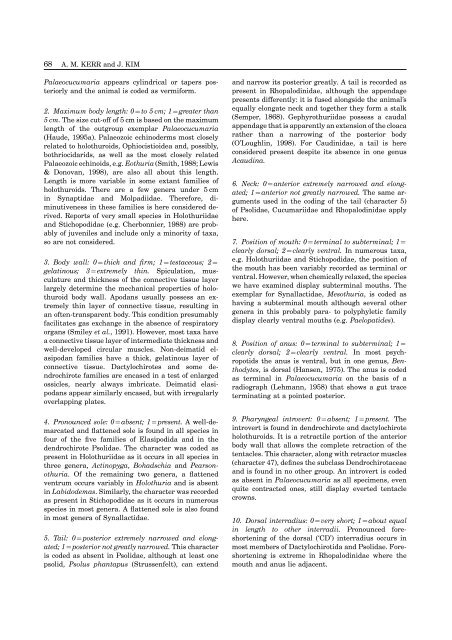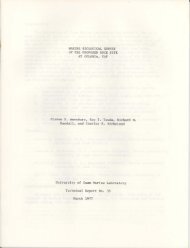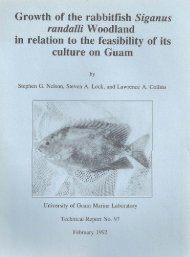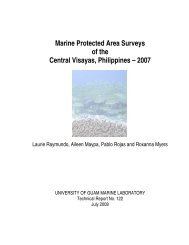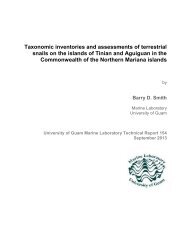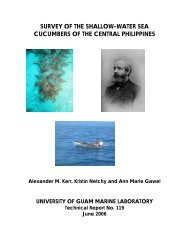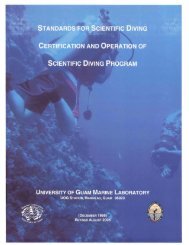Phylogeny of Holothuroidea (Echinodermata) inferred from ...
Phylogeny of Holothuroidea (Echinodermata) inferred from ...
Phylogeny of Holothuroidea (Echinodermata) inferred from ...
Create successful ePaper yourself
Turn your PDF publications into a flip-book with our unique Google optimized e-Paper software.
68 A. M. KERR and J. KIM<br />
Palaeocucumaria appears cylindrical or tapers posteriorly<br />
and the animal is coded as vermiform.<br />
and narrow its posterior greatly. A tail is recorded as<br />
present in Rhopalodinidae, although the appendage<br />
presents differently: it is fused alongside the animal’s<br />
equally elongate neck and together they form a stalk<br />
(Semper, 1868). Gephyrothuriidae possess a caudal<br />
appendage that is apparently an extension <strong>of</strong> the cloaca<br />
rather than a narrowing <strong>of</strong> the posterior body<br />
(O’Loughlin, 1998). For Caudinidae, a tail is here<br />
considered present despite its absence in one genus<br />
Acaudina.<br />
2. Maximum body length: 0=to 5 cm; 1=greater than<br />
5cm.The size cut-<strong>of</strong>f <strong>of</strong> 5 cm is based on the maximum<br />
length <strong>of</strong> the outgroup exemplar Palaeocucumaria<br />
(Haude, 1995a). Palaeozoic echinoderms most closely<br />
related to holothuroids, Ophiocistioidea and, possibly,<br />
bothriocidarids, as well as the most closely related<br />
Palaeozoic echinoids, e.g. Eothuria (Smith, 1988; Lewis<br />
& Donovan, 1998), are also all about this length.<br />
Length is more variable in some extant families <strong>of</strong><br />
6. Neck: 0=anterior extremely narrowed and elongholothuroids.<br />
There are a few genera under 5 cm<br />
ated; 1=anterior not greatly narrowed. The same arin<br />
Synaptidae and Molpadiidae. Therefore, diguments<br />
used in the coding <strong>of</strong> the tail (character 5)<br />
minutiveness in these families is here considered de<strong>of</strong><br />
Psolidae, Cucumariidae and Rhopalodinidae apply<br />
rived. Reports <strong>of</strong> very small species in Holothuriidae<br />
here.<br />
and Stichopodidae (e.g. Cherbonnier, 1988) are probably<br />
<strong>of</strong> juveniles and include only a minority <strong>of</strong> taxa,<br />
so are not considered. 7. Position <strong>of</strong> mouth: 0=terminal to subterminal; 1=<br />
clearly dorsal; 2=clearly ventral. In numerous taxa,<br />
3. Body wall: 0=thick and firm; 1=testaceous; 2=<br />
e.g. Holothuriidae and Stichopodidae, the position <strong>of</strong><br />
gelatinous; 3=extremely thin. Spiculation, musventral.<br />
However, when chemically relaxed, the<br />
the mouth has been variably recorded as terminal or<br />
species<br />
culature and thickness <strong>of</strong> the connective tissue layer<br />
largely determine the mechanical properties <strong>of</strong> holo-<br />
thuroid body wall. Apodans usually possess an ex-<br />
tremely thin layer <strong>of</strong> connective tissue, resulting in<br />
an <strong>of</strong>ten-transparent body. This condition presumably<br />
facilitates gas exchange in the absence <strong>of</strong> respiratory<br />
organs (Smiley et al., 1991). However, most taxa have<br />
a connective tissue layer <strong>of</strong> intermediate thickness and<br />
we have examined display subterminal mouths. The<br />
exemplar for Synallactidae, Mesothuria, is coded as<br />
having a subterminal mouth although several other<br />
genera in this probably para- to polyphyletic family<br />
display clearly ventral mouths (e.g. Paelopatides).<br />
well-developed circular muscles. Non-deimatid elasipodan<br />
families have a thick, gelatinous layer <strong>of</strong><br />
connective tissue. Dactylochirotes and some de-<br />
ndrochirote families are encased in a test <strong>of</strong> enlarged<br />
ossicles, nearly always imbricate. Deimatid elasi-<br />
podans appear similarly encased, but with irregularly<br />
overlapping plates.<br />
8. Position <strong>of</strong> anus: 0=terminal to subterminal; 1=<br />
clearly dorsal; 2=clearly ventral. In most psych-<br />
ropotids the anus is ventral, but in one genus, Benthodytes,<br />
is dorsal (Hansen, 1975). The anus is coded<br />
as terminal in Palaeocucumaria on the basis <strong>of</strong> a<br />
radiograph (Lehmann, 1958) that shows a gut trace<br />
terminating at a pointed posterior.<br />
5. Tail: 0=posterior extremely narrowed and elongated;<br />
1=posterior not greatly narrowed. This character<br />
is coded as absent in Psolidae, although at least one<br />
psolid, Psolus phantapus (Strussenfelt), can extend<br />
4. Pronounced sole: 0=absent; 1=present. A well-de-<br />
marcated and flattened sole is found in all species in<br />
four <strong>of</strong> the five families <strong>of</strong> Elasipodida and in the<br />
dendrochirote Psolidae. The character was coded as<br />
present in Holothuriidae as it occurs in all species in<br />
three genera, Actinopyga, Bohadschia and Pearson-<br />
othuria. Of the remaining two genera, a flattened<br />
ventrum occurs variably in Holothuria and is absent<br />
in Labidodemas. Similarly, the character was recorded<br />
as present in Stichopodidae as it occurs in numerous<br />
species in most genera. A flattened sole is also found<br />
in most genera <strong>of</strong> Synallactidae.<br />
9. Pharyngeal introvert: 0=absent; 1=present. The<br />
introvert is found in dendrochirote and dactylochirote<br />
holothuroids. It is a retractile portion <strong>of</strong> the anterior<br />
body wall that allows the complete retraction <strong>of</strong> the<br />
tentacles. This character, along with retractor muscles<br />
(character 47), defines the subclass Dendrochirotaceae<br />
and is found in no other group. An introvert is coded<br />
as absent in Palaeocucumaria as all specimens, even<br />
quite contracted ones, still display everted tentacle<br />
crowns.<br />
10. Dorsal interradius: 0=very short; 1=about equal<br />
in length to other interradii. Pronounced foreshortening<br />
<strong>of</strong> the dorsal (‘CD’) interradius occurs in<br />
most members <strong>of</strong> Dactylochirotida and Psolidae. Foreshortening<br />
is extreme in Rhopalodinidae where the<br />
mouth and anus lie adjacent.


